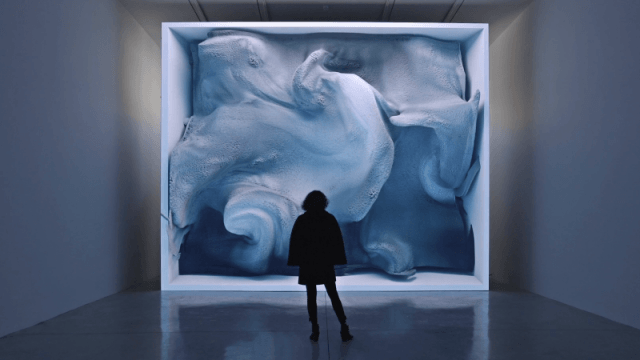Overarching Thoughts
Waltz mainly discusses how generative art in itself though highly precise and ‘controlled’ in the way the system which produces it is designed, its aim is to reproduce an outcome that is as close to nature as possible — organic and spontaneous phenomena which carry the inherent characteristic of ‘life’ itself — mutability and hence unpredictability. As artists and designers we want to create experiences that replicate the poetic nuances of what constitutes ‘living’. Yet we are acutely and admittedly aware that we are inextricably limited by our logic and human perception. Though we are able to ‘feel’ various intangibles such as emotion, we mostly attach these ‘feelings’ to objects or people to give them some sort of physical association and meaning. Science explains that chemicals such as dopamine and serotonin are responsible for these ‘feelings’ yet there is a somewhat spiritual and noetic aspect to these emotions that we simply can’t fathom — concepts of the soul etc.
Aware that we are only limited by our own human condition and perception, and that we simply do not have the power to ‘play god’ and detach ourselves from this schema or worldly experience to deconstruct everything from a completely unbiased, pure and distilled approach, we then turn to the use of software systems and algorithms. In a way these systems operate out of the parameters that confine ‘life’. They lack intuition and perception and their ‘learning’ depends on what information we choose to feed them. However this then renders these highly precise systems with the ‘non existent human-objectivity’ to assist us in deconstructing our experience as a detached entity. What we have inbuilt in us, that these computerised binary systems lack is the very thing that limits us from fully taking apart (and hence recreating) the condition of ‘to be living’. We cannot put together something we do not even know how to take apart.
This then brings us to the systems we rely on. Though these systems are inanimate and devoid of any sort of ‘lively’ essence, they too produce unpredictabilities. A ‘glitch’ in the matrix or a ‘bug’ that comes up once in awhile, derailing the system from producing its supposedly premeditated outcome, resulting in moments of deviance and dysfunctionality. This capability and propensity for highly objective and parametric systems to produce unpredictabilities while lacking life, forms the key fundamental basis for generativity to exist as a significant philosophy or methodology in answering the questions we have always sought out.
The implications of a set algorithms having some sort of possible innate biases that ‘mimic’ or rather come close to mirroring the similar unpredictabilities seen in nature, while being tangible and adjustable to our touch, is highly significant. Essentially we now have in our hands a modifiable, parametric ‘replica’ that comes as close as possible to ‘life’- something we have zero control over. Whether the way it manifests is indeed controlled by a ‘higher being’ or simply operates on some sort of universal code, or balance, it is beyond us as humans as ‘life’ in itself is not in our power. We are executioners of life in the way we carry it in our physical bodies, yet when we age it is ‘taken’ away from us. We reproduce but we cannot ‘ inject ‘life’ into something. ‘Life’ in itself is not exclusive to our race. Yet given our highly developed cognitive functions and emotional perception, we are inevitably unable to simply dismiss it — existentialism, nihilism, solipsism, absurdism are all simply manifestations of the human acute awareness and frustration of our inability to understand or comprehend fully the greater world we live in.
As designers we have to apply this intuition with suitable technical skills to create a complex and interesting generative system. Waltz explains that ‘reverse engineering’ is an essential approach towards generativity — we try to ‘plan’ the intended outcome (together with its possible ‘set of unpredictabilities’) and decide what type of software, input algorithms or data set we can utilise to produce this result.
Further thoughts
In the ‘void loop()’ section, Waltz talks about the rise of the net and how advancements in technology, together with our fascination of it, led to early exploratory works of generativity. Though they were relatively ‘crude’ and rather simple (far from the likes of veracity and complexity with associate with technology today), they fundamentally operated as valid generative closed systems. Waltz suggests that because of this closed system characteristic, and the lack of need for interactivity, coupled with the focus on the infrastructure and nature of the system itself, generative art is closer to fine art than it is to media art.
This then contextualises the approach he is suggesting for us as designers to adopt. Rather than creating an experiential piece that capitalises on user-system interaction, we should analyse the materiality of the system, it’s patterns and behaviour and modify it to our desire. It is then a process that requires a sufficient level of ‘stringency’ and discipline. We have to be precise about how we piece the elements of the system together the same way a painter precisely places brush strokes onto a canvas. It is only with this precision that we will be able to create a system that is able to function to produce profound yet meaningful outcomes.
The point of generativity is not to directly intervene/alter in the system’s process but rather to first deconstruct it and understand the potential underlying unpredictabilities it is capable of producing on its own. We then modify or add elements to it to ‘capture’ or record these unpredictabilities. We are hence required to be careful in the way we construct the system — whether digital or analogue, that each of the element is calibrated and not artificially biased to ‘rig’ the outcomes. The beauty of the outcome is not in its visual appearance or how close it is to the artist’s ideal but rather it being a meaningful and conceptual representation/manifestation of the non visible nuances and characteristics that are inherent in the designed system.
However by designing the system with some sort of discretion, we will then able to predetermine one that is able to also produce visually/mentally stimulating outcomes. Here our intuition and understanding of world views come into consideration as we make deliberate choices. Choosing to add Element A instead of B can and will result in a very different set of outcomes but which would be a more effective representation of the system? ‘Effective’ in a sense where it targets and attacks or destabilises our worldview. Does it satiate our craving to want to process intangible phenomena or offer any sort of visible, identifiable respite to deepen/expand our understanding of the relationship we have with these non discrete, poetic entities.
Data Scultpures
In the final section, Waltz fantasises about the idea of generative art completely moving off the screen (he is careful to remind us that it is indeed not limited to just pixels displayed on a screen). He believes that with technology enabling us to “extrude virtual forms” onto three dimensional space itself, this opens up the possibility for generativity’s exploration to expand even further in the contemporary world. Waltz also mentions the experimentation of data sculptures, ‘representing normally intangible information flows as physical manifestations.’
— Refik Anadol, Engram : Data Sculpture for Melting Memories
The above work is an example of data sculpture I personally find fascinating.
Earlier I mentioned how we as humans are constantly looking for ways to grasp and portray the intangible processes that we experience in our brains and body. ‘Engram” successfully harnesses and measures the empirical aspect of our cognition to then use it as input data to essentially produce an organic visual ‘life-like’ representation of our memories. The outcome is profound and mesmerising — through Generative Methodology we are able to appreciate the sheer wonderment of our brain and its functions via an almost spiritual experience. Though there is no direct interactivity and it is a closed system, there is psychological and emotional dialogue between the work and viewer intuitively. This dialogue then helps us process and internalise the intangible phenomenology surrounding our memories.


Exceptionally well though and skillfully written!
This is a good example of how a thorough and careful research and broader consideration of the topic can inform our creative work.